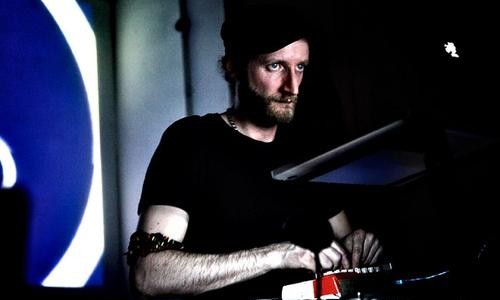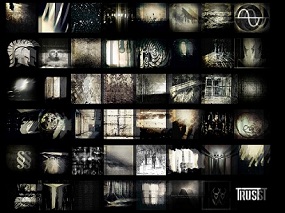Knowledge _ Interview with Dadub
Would you mind talking a little about how you approach doing your live set? I’ve heard you talk about splitting up the responsibilities, so don’t want you to feel like you are repeating yourselves.. but maybe you could talk a little about the technical aspects of what’s involved?
Daniele: It’s more or less the same easy set-up. We always just use our laptops and some midi controllers. Even when we play live, we try to keep continuous tension with the audience. A complex set-up may be a bit risky as you might lose the connection or intensity during the performance. We tend to use really well produced and processed loops.
Our live set is an experiment of how a loop can sound on a big sound system. We still use loops from about 3 or 4 years ago.. but with different mix downs and post productions it will always sound different. It’s our research in trying to find a good dimension of sound. We don’t focus too much on the kind of set-up that we have.
So it’s more the material that you use, rather than the tools that you use to perform..
Daniele: Exactly and the perception of our sound depends a lot on the kind of overdubbing that Giovanni makes, which is quite particular..
Giovanni: We have 2 laptops running Ableton. Daniele is in charge of triggering sequences and building the arrangement in real time. I get the output from his soundcard and process it through a chain of about 7 or 8 effect channels that are feeding into eachother. One channel with delay, another with reverb, delay, 2 or 3 channels creating feedback going into reverbs etc..
Then I have a simple midi controller. A Evolution X Session from 12 years ago. It’s just got 16 knobs. The best way I’ve found to control this complex system is to assign a single midi knob to many parameters, so that when I turn a knob, I’m not just changing one parameter in the effects chain. This way, it changes 3 or 4 parameters at a time. The same knob has different scaling values, or different directions. When I turn, it makes the frequency of one filter delay go up and another go down. It may also open the reverb space. By keeping a simple set-up I managed to recreate that instinctual feeling that I had when I was playing drums. After a while I’m not thinking like “I have to turn this knob now to get that effect”. It’s become instinctual routine. I do what I do because I’m listening to the audio and I feel that the tension in a certain moment is going down, so I’ll try add high frequencies or add a rising reverb wash to compensate for the lack of frequencies that are coming from Daniele’s soundcard.
That’s really interesting…It seems as you are essentially bringing your studio out to the club?
Giovanni: We use almost the same set-up in the studio. We compose a track and I’ll process it in the same way that we do when we play live. In a way, the tracks that we release have a part of live performance in them. I guess this is why people feel something lively in them, that it’s not just a midi part. It really helps to create that organic feeling that you can hear in our tracks. If you try to do it by programming envelopes, with a complicated screen, it’ll never sound as natural and direct as doing it by physically moving something.
The real time processing that I do live, I’ll try to compensate the power of the bass with a lot of high frequency content. When you go to a club, most of the energy and sound pressure that you get is based on the subwoofer. If you can add the same physical power in the high frequencies then people really go crazy sometimes. It’s really funny because you have hundreds of people in front of you and if you turn a couple of knobs the right way, they just go crazy. You really feel it. It’s an exchange of energy that you can control through a midi controller haha.
So it’s the equivalent of a drummer doing a drum roll then?
Giovanni: Exactly. It’s like a continuous 3 hour drum roll solo for me haha
Haha – and just like a drummer, do you ever get blisters on your fingers from twisting midi?
Giovanni: Well, once we played a DJ set for 7 hours and by the end, my index and thumb were hurting. We dance and sweat a lot, so sometimes my hands are so sweaty I don’t manage to turn them haha. I don’t like when you go into a club and the DJ is looking at the screen, not moving. It’s counterproductive for the DJ. If you see the performer is really enjoying what he’s doing, then his energy goes through you immediately.
Haha – Absolutely!



Hagbard Celine
Feb 24. 2013
Fantastic indepth interview with the guys. Loads of interesting comments and some very good technical tricks and tips. They have a great sound, and a hypnotic delivery of complex textures and rhythms that is communicated effectively in waves and layers of sonic information, direct in this piece, this interview should put most online publications to shame. Great stuff on a great act.
ICN
May 11. 2013
Hi Celine,
Only seeing your comment now. Thanks a lot for the kind words. They’re great fellas, arent they?
Cheers,
John
Ashley Borg
Feb 27. 2013
This is probably my fav ever written interview. Amazing levels of insight, I feel like I’m actually achieving a higher level of learning by reading alone. What’s really good is how their passion and personality come though, part of this must be attributed to the interviewer, who set an excellent tone, with his manner and questions.
5/5